Welcome to FISH FOOD TIMES
Jul. 2018 issue No.175

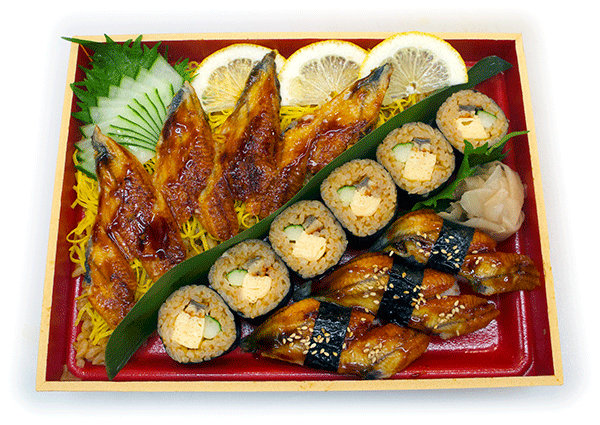
Eel Sushi Assortment
An eel that the high price stability became normal
Also this year, midsummer day of the ox will come on Friday, July 20, this year there will be the second midsummer day of the ox, on August 1 (Wednesday).
The eel market continues to soar this year, the most recent price at the Tsukiji fish market has been moving on the average as follows.

The raw eel that is subject to the price trend is the average price of the domestic Anguilla japonica species, and depending on the size the price goes up and down.
The most recent market price of the eel unloaded at pond price in the production area has been shifting by size as follows, so it seems that Tsukiji is trading by almost the same sort of evaluation by size.
| size | Shizuoka Prefecture district | Kyushu area |
|---|---|---|
| 3P | 4,200�`3,900 �~/kg | 4,100�`3,900 �~/kg |
| 4P | 4,800�`4,500 �~/kg | 4,700�`4,500 �~/kg |
| 5P | 5,300�`5,000 �~/kg | 5,200�`5,000 �~/kg |
Glass eels is a poor catch
The reason why the eel market soaring in this way is that the eels' fry fish glass eels has become a poor catch compared with the usual year.
In the period of picking up glass eels, each prefecture sets a certain period from December to April of the following year and gives special permission to fishermen approved through fishery cooperatives and others. However, since the fishing until January this year was extremely poor fishing as unprecedented as ever before, the price of glass eels has exceeded 1 kg 3 million yen, glass eels ponded last year grew from culture pond the shipment size called "hineko" is the price like the above graph.
The glass eels of 1 kg is 3 million yen rough estimate is roughly "one bowl in one bowl", and this 1 kg contains glass eels of about 5,000 fishs or so and in case of a simple calculation the price per fish is about It will be 600 yen. The size of the glass eels of 1 fish 600 yen is 0.15 to 0.2 g, it is shipped as a product after growing to a size of about 200 g to 250 g on average about 1,000 times from half a year to 1 year given a feeding in a culture pond . The shipping price is not only the purchase price of 1 fish, but also the reduction of the survival yield due to the death of glass eels, which is unknown unless the end of aquaculture, the heavy oil fee which warms the house of the cultivation pond, personnel cost, profit cost is added and it is determined.
Of course, as in this year when glass eels is a poor catch, even if we purchased last year's glass eels purchase at a price less than half of this year, the price of adult eels called hineko last year was depending on the supply relationship is set to a price commensurate with the market price.
The following graph relates to the situation of glass eels in the document "About the circumstances surrounding the eel and countermeasures" just released by the Fisheries Agency in June. (In this issue, since there are plenty of graphs referencing this material after this, we will explain this content, but I would like this to be acknowledged to understand the eel situation this year. In addition, I do not translate the material itself announced by English)
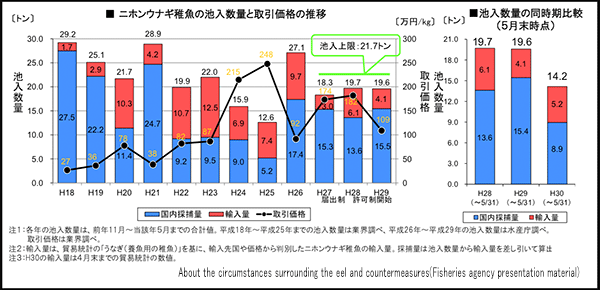
According to this material, although the glass eels transaction price of 2018 is not mentioned, the quantity of glass eels in Japan put in culture pond is 14.2 t which is less than the upper limit of 21.7 t set by the country . Among them, 8.9 t has been captured in the country and 5.2 t is imported glass eels. According to the explanation of the material, the glass eels fishing from November to January this year was an extremely poor fishing, but since the fishes have improved in February this year, the introduction of glass eels has advanced to the culture pond at the peak of March.
The eel aquaculture industry was required to be notified by the Inland Sea Fishery Promotion Act in November, 2013. In June 2015, glass eels' putting the pond quantity upper limit was decided for each individual eel farming business. The breakdown is in the table below.
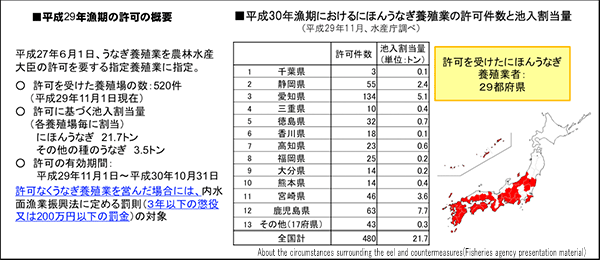
However, the glass eels' putting the pond achievements in 2018 ended in the numbers shown in the table below.
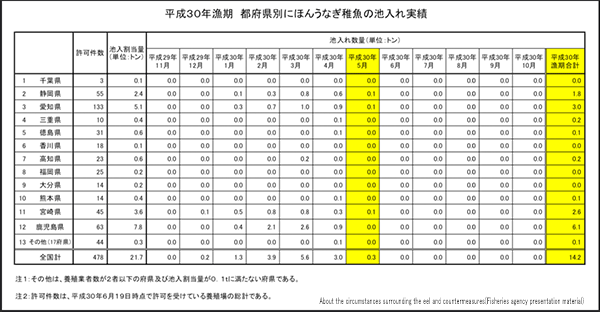
The glass eels are picked up by a small fixed net set on the coast or a river, especially during the night of the new moon where the night is dark when the light of the moon is not visible, during the period when fishing is permitted. Since glass eels is as big as 6 cm in length and 0.2 g in weight, it is extremely small, about a few grams per person per day and can be carried with a small amount of water. Therefore, in reality there is a reality that it is very difficult for the government to manage the amount of harvest.
Glass eels collected by authorized fishermen are gathered to collectors and there is a circulation mechanism that is passed to aquaculturist via multiple distributors. For example, in the fishing season of 2016, the reported number of catch in the country was 7.7 tons and the import quantity was 6.1 tons, the total was 13.8 tons, but the aquaculturist's puttig the pond reported quantity in that year was 19.7 t, an error of 5.9 t occurred as a report leak in the number of ponds.

The cause of such error is as follows: �@ The captive person does not want others to know the captured quantity (I want to keep a good collection place secret, avoid envy of a big catch) �A At a higher price, I want to sell to people who are not designated ship-to destinations. �B Capture by unauthorized poaching, etc. seems to be considered.
As the Fisheries Agency seems to be pursuing the resource management of glass eels and the appropriate grasp of the amount of harvest, but in any case 1 kg is about to suck the "delicious juice" of the sea diamond exceeding 3 million yen , various races will come together. There are not always bad people who are savvy enough, and it is presumed that it will be difficult for the Fisheries Agency to continue as expected. By the way, since the weight of a carat of diamonds is 0.2 g, the fact that the weight of glass eels is almost the same as 0.2 g is a number that happens to match strangely and is interesting.
Changes in eel supply volume
First of all, why glass eels came to be traded at such a high price, the eel eel (Anguilla Anguilla species) which was also known as the French eel called from around 1985 began to be imported from China, There are historical reasons that the eel eels have realized a very cheap price in Japan, expanded the base of eel consumption, and that Nippon eel (Japonica species) also went down to popular price.
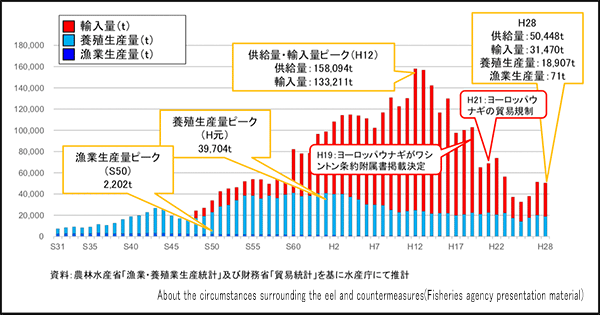
However, the European eel via China that caused the whirlwind at cheap prices in the Japanese eel industry changed its flow since it was published in the Annex to the Washington Convention in 2007. Since it was designated as Appendix II in 2009, European eels have been regulated by dealing and the import volume has decreased greatly. But then at that time in Japan the European eel, which was imported in large quantities from China, has already expanded the domestic eel consumption base widely, but this time the European eel as the supply of the products became thin, eel products became unable to sell cheaply as before as ever since.
As shown in the table below, the International Conservation Union for Nature Conservation (ICUN) has classified European eel as Endangered species IA of the red list category and designated as "extremely high risk of extinction in wild in the near future" are doing. Also, Japanese eel and American eel are classified as endangered species I B and assume that there is the danger of extinction next to the European eel as "species of high risk of extinction in the wild in the near future". IA and IB are the difference whether the word critically comes or not, and it seems that the Japanese eel whose word is not attached is not as dangerous as the European eel.

In the CITES Washington Convention (Convention on International Trade in Endangered Species of Wild Fauna and Flora), as shown in the table below, European eels are listed in Appendix II and originally European eels are "in commercial trade and high seas " EU is taking measures to prohibit substantial export by not issuing a license for export, although it should be possible".
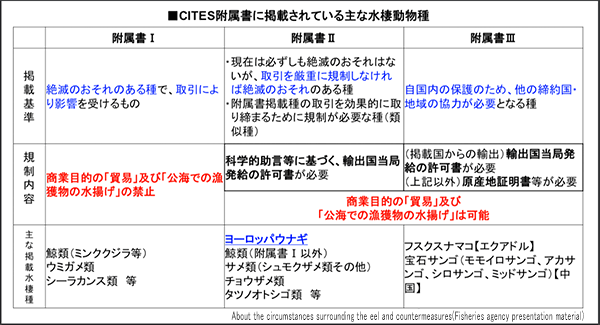
Influence of heterogeneous eel
Through the explanation so far utilizing the data released by the Fisheries Agency, I think a little understandable that European eels historically imported from China has been stirring the Japanese eel industry and the eel commodity market.
However, China's nurturing industry does not withdraw as it is against the EU export ban measures. Now they seem to have imported 5.2 tons of glass eels from European eels (Anguilla Anguilla species) from Morocco in Africa this year. The amount of this glass eels is 3,120 tons on the basis of live eels and 2,300 tons of product eels are likely to be brought into Japan. Not only that, China has puttig the pond by importing a total of 33 tons of glass eels from 25 t of Vicaras species from the Philippines and Indonesia, 8 t of Rostratas species from the United States, breeding these into eel, It seems that he plans to export about 3,000 t of eel to Japan.
The newly handled Rostratas species in China are endangered species I and the Vicaras species are classified as semi-threatened species (vulnerable surviving substrates), and with this momentum imports of these glass eels If it continues, even in the United States and Southeast Asian countries, it may be doing the same movement as the EU regulating Europe eel exports.

Although the word "repeat history" may not be used at such times, it can not be said that future developments similar to the past are not awaiting, so now we will deal with it I wonder if it should be.
FISH FOOD TIMES has been referring to eels many times so far, the first one is the July 2008 issue "Eel Sashimi", the second one is the July 2012 No. 103 "Bad money drives out good money" , The third time was January 2014 issue No. 121 "Unachirashisushi". It will be the fourth time to eel the theme this time. In 2008 and 2012, when the eels' price was raised due to the failure of glass eels, in 2014, a lot of glass eels were captured from the beginning of the fishing season and three times as much as the previous year was captured, and the glass eels price was It was a year of turbulence that it was about 250 thousand yen which was sufficient from 1 kg 2.5 million yen of the previous year.
With FISH FOOD TIMES there is no other theme of the same fish four times, but the reason is that stakeholders selling eel products are trifling with glass eels every year, they can be ignored It is because there is a very big presence. Also, as there is no shortage of trendy topics such as natural environment and natural resources, there are things that will deeply influence the attitude of the business of those who deal with them, eels are "only one of the fish" It is because it is in a position not to say.
Bad money drives out good money
Then, how do retailing officials fight to sell "eel kabayaki" which is one of eel products showing such a large presence like this?
There has been a movement to sell merchandise that can replace eel, kabayaki which has become expensive recently, and there was a sardine kabayaki, saury kabayaki etc. that existed as before as one of them, but also In addition, catfish kabayaki and toro salmon kabayaki etc are recently being talked about. However, if you are watching how much commodities such as sardines kabayaki and saury kabayaki have been accepted by consumers as eel substitute products, I think that it is almost impossible to see whether these new items will replace the eel kabayaki. "Kabayaki goods" using fish which are not these eels should not be placed as substitutes for eels, but should be "a selection of plus alpha products with a supporting role" as a different kind of kabayaki item.
On the other hand, although it is a real eel, what will you do with eels that are not japonica species called "heterogeneous eel"? I think that if you stock these items you will not be able to sell with the appeal of cheapness, but these should be considered as "it will be hard to sell products that use expensive Japanese eel as much as it was sold if it sells."
I think that the product called Eel kabayaki is not a product that consumers would feel like purchasing at least once a week like mass fish. Most people try to always buy midsummer day of the ox every year but should be considered as a product that will not move to purchase unless it is something special except midsummer day of the ox, I think that it is a majority of consumer sentiment that trying to buy a domestically produced eel kabayaki even though it is somewhat impossible only midsummer day of the ox once a year.
Such consumers are categorized as cheap Anguilla species, Rostrata species, Vicaraca species etc, and at the time of the midsummer day of the ox, consumers are in a shop where there is less selection of more expensive Japonica species, I would like you to think about whether to visit to purchase Japanese eel kabayaki.
FISH FOOD TIMES used to be Gresham's law of "Bad money drives out good money (high quality items do not get very popular, quality poor quality popular)" previously recounted by a man named Gresham, who served as the royal treasurer of Britain in the past I thought that this is just the word with the truth of economic principles.
Applying this proverb to the fish shop, if you start to line up "bad money" like Rostrata or Vicaras at store eel kabayaki selling area, Anguilla species with a sense of overheating will be driven to the corner. Furthermore, "good money" where the price of hand-burned with bincyo charcoal using domestic Japonica species stands out is not sold at all and these will be "to be driven out" from the store.
In such fish shops, as a result many customers like to be good if it is cheap, people who can afford money to think that genuine is good even if it is somewhat expensive will not come close to that, only cheap goods will be sold, and fish shops It will become increasingly difficult to increase sales. It would be fine if the shop is in a style that calls customers with reasonable price, but it should be considered that there is nothing after that style store that makes quality fresh and fresh for sale.
The following image is a domestic Japonica species which the company which the author once guided was selling at the fish selling place, this is eel kabayaki hand-baked with Bincho charcoal. This eel kabayaki boasts tremendous popularity, it is a product that can guarantee quality, and it was also a signboard product of a fish shop.
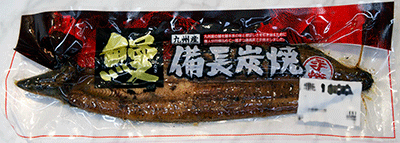
On the other hand, the image below is the eel kabayaki sold by a major fish shop company that operates a fish shop as a department store tenant as of June this year. The selling price was Aichi Prefecture's headless cut open along the back 182 g is base price 2, 759 yen, and the cut open along the back 197 g from Kagoshima prefecture was the selling price of base price 2, 574 yen.
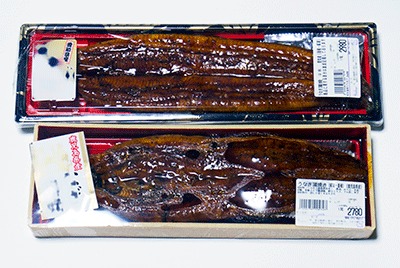
![]()

If you compare this image of headless and headon firmly, do not you think the reader who is a professional fish does something strange in the balance of that selling price?
When I saw these displayed on the fish shop, this was somewhat strange and appealing to the sense of smell intuitively, so I bought these and weighed it.
First of all it is an appearance judgment. Headless with high selling price is long and is a feeling of "tall body plump type". On the other hand, cheaper selling price is "fat stumpy type".
The selling price of "tall body plump type" of 182 g in weight is 2,759 yen, but although the weight of "fat stumpy type" is 197 g, the selling price is 2,574 yen, which is cheaper though it is heavier. Why would such a reversal phenomenon occur?
Although it is only speculation, although both are domestic eel kabayaki, "tall body plump type" is Japonica species and "fat stumpy type" is probably an Anguilla species. This morphological feature is the difference between Japonica and Anguilla species, and if you think that the domestic eel kabayaki is surprisingly cheap at the fish store, it should be suspected that the glass eels of the European eel were brought to Japan and breed .
However, if the relatively cheap eel kabayaki selling at this shop is a production area forged, this is not to be the case if it proves the fact that it domestically cultivated from the glass eels stage to the adult eel. Since the store has no obligation to display the difference between Japonica species and Anguilla species, it will not be an unfair indication.
In other words, even if it is expressed as the domestic eel, kabayaki at the current Japanese fish shop or restaurant, it is not necessarily the Japanese eel that the Japanese have eaten from long ago, which may be a European eel, an American eel and a Philippine eel It is impossible to distinguish between the real appearance and reality is that there is no choice but to ask the person who cultivated an eel.
Efforts to increase the sense of cost performance
Originally eel products in Japan were special high-grade foods, so I think that I should sell it at reasonable prices corresponding to the market price rather than selling it cheaply, but as I thought, the fish retailer for those involved in the business, it seems that no time to be talking so complacently is the true intention.
Therefore, I would like to propose that it is "Efforts to increase the sense of cost performance" that one wants to consider as a countermeasure for not lowering sales even a little. For example, "eel sushi assortment" in the top image, this is conscious of to increase the sense of cost performance.
The items of the following images are from the left, eel chirashi sushi, eel cyuumaki sushi, eel nigiri sushi, but if you are to sell these items separately for each person, you have to afford a reasonably high selling price.
| Individual various eel sushi products | ||
|---|---|---|
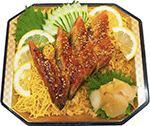 |
 |
 |
| eel chirashi sushi | eel cyuumaki sushi | eel nigiri sushi |
 |
||
| eel sushi assortment | ||
However, if you combine these as "eel sushi assortment" instead of separate items, you will get a feeling of volume, so if you do not make your selling price too high and do not make it too high, you can get the sense of cost performance in that balance It should be able to express by goodness.
In the case of this year, a decent product of 60 sizes, which is the standard size of domestic eel kabayaki, probably will be a selling price of around 2,500 yen per regular price. So consumers will feel an expensive feeling compared to last year. However, if you make an eel sushi assortment product that contains sushi rice as a total of 500 grams, like the commodity of the top image, it will be a product with content equivalent to almost two servings, so the selling price of this item can be 1,980 yen , I think that customers can feel the sense of cost performance.
Just do not misunderstand that these are not main products of midsummer day of the ox. The main way to sell is essentially eel kabayaki, and I would like to say that if you do not realize a little troublesome product on the shop as a supplement to its sales, there is a danger that the sales of eel products will be taper off.
Since the product called eel now is a product made from scarce fish that is posted on Red List, it should not be thought that this is not an era of selling these at bargain prices steadily.
After the customer eats the eel product, "It is slightly expensive, it was very delicious, I would like to be able to say that I want to eat when next time money can afford." We think that it is important to stock "genuine delicious eel" and make efforts to make customers become repeaters again.
An opinion and the communication are to iinfo@fish food times
Date of updating 1 Jul. 2018
